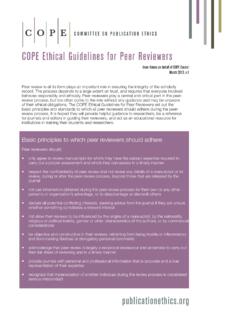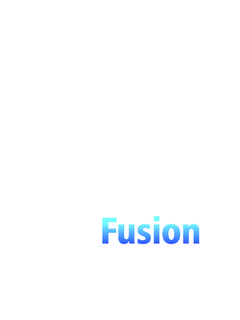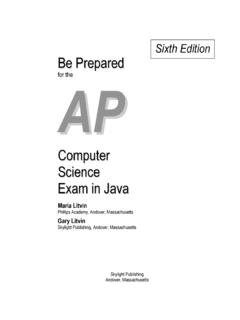Transcription of PNAS Information for Authors
1 PNAS | November 2018 | vol. 115 | i-viiPNAS Authors , editors, and reviewers come from around the globe. Submissions are welcomed from all researchers. Authors do not need to have a connection to an NAS member to publish in PNAS. More than 75% of published articles are submitted directly to PNAS, not as Contributed articles by NAS members. Accepted papers must be of exceptional scientific importance and intelligible to a broad scientific audience. An NAS member makes the final decision for each make its coverage more representative of the disciplines that comprise the NAS, PNAS has issued a Call for Papers in the Physical and Social is committed to transparency in its editorial review process.
2 As a member of the Committee on Publication Ethics (COPE), PNAS supports its core practices and is committed to transparency in scholarly AND SCOPEPNAS publishes research reports, Letters, Front Matter maga-zine content, Commentaries, Perspectives, and Colloquium Papers. In accordance with the guiding principles established by George Ellery Hale in 1914, PNAS publishes brief first an-nouncements of NAS members and foreign associates more important contributions to research and of work that appears to a member to be of particular importance. PNAS is a general science journal and all papers should be intelligible to a broad scientific TypesResearch reports describe the results of original research of ex-ceptional importance and are published with a brief, author-written Significance Statement that describes the significance of the work.
3 Unsolicited research reports are in January 2019, Brief Reports describe observa-tions of immediate impact that may hold the potential to initi-ate new avenues of research, provide compelling new data on controversies of broad interest and long-standing open ques-tions, or provide a concise conceptual advance. Brief Reports are limited to 2,000 words or 15,000 characters (including spaces), typically include no more than 2 graphical elements, and sup-porting Information is limited to essential supporting datasets (no additional methods, tables, or figures are permitted). Brief Reports receive an accelerated review and production process of ~3 months and are open access.
4 All Brief Reports follow the Direct Submission mode of review. Letters are brief online comments that allow readers to con-structively address a difference of opinion with Authors of a re-cent PNAS article. Readers may comment on exceptional studies or point out potential flaws in studies published in the journal. Letters may not include requests to cite the Letter writer s work, accusations of misconduct, or personal comments to an author. Letters are limited to 500 words and 10 references, and must be submitted within 6 months of the online publication date of the subject article. Unsolicited Letters are Matter is an expanded front magazine section aimed at a more general level of discussion, tackling the stories of science in interesting ways.
5 Sections include Opinions, News Features, Science and Culture, Inner Workings, and Core Concepts. Front Matter is written only at the invitation of the Editorial call attention to articles of particular note and are written only at the invitation of the Editorial present a viewpoint on an important area of re-search. Perspectives focus on a specific field or subfield within a larger discipline and discuss current advances and future direc-tions. Perspectives are of broad interest to nonspecialists and may add personal insight to a field, but should be balanced and objective. Perspectives are written only at the invitation of the Editorial Board and evaluated for publication using the same process as Direct Papers are reports of scientific colloquia held under NAS auspices and are written only at the invitation of the Editorial papers are evaluated solely on their scientific merit by peers, not by professional staff editors.
6 A three-tier review process for research reports includes review by an Editorial Board mem-ber from one of the 31 NAS disciplines, an NAS Member Edi-tor, and independent peer reviewers. NAS Member Editors are professional scientists and active researchers. A list of Editorial Board members and their disciplines appears on our AND JOURNAL POLICIESD irect Submission. The standard mode of transmitting manu-scripts is Direct Submission. Direct Submissions account for more than 75% of articles published in PNAS and do not need to be sponsored by an NAS member. The Editorial Board screens all incoming submissions and may reject manuscripts without further review, or review and reject manuscripts that do not meet PNAS standards.
7 More than 50% of Direct Sub-missions are declined by the Editorial Board without additional review, within 2 weeks on average. For papers that are sent on to an editor and reviewers, the average time to receive a decision is 41 days. If accepted, Authors have their articles published online as soon as 4 5 weeks after acceptance. Authors must recommend three appropriate Editorial Board members, three NAS members who are expert in the paper s scientific area, and five qualified reviewers. The Board may choose someone who is or is not on that list or may reject the paper without further review. Authors are encouraged to indi-cate in their cover letter why their suggested editors are qualified to handle the paper.
8 See the directory of PNAS Member Editors and their research interests. The editor may obtain reviews of the paper from at least two qualified reviewers, each from a dif-ferent institution and not from the Authors institutions. PNAS will invite the reviewers, secure the reviews, forward them to the editor, and secure any revisions and subsequent re-views. The name of the editor must remain anonymous to the author until the paper is accepted. Direct Submissions are pub-lished as Edited by the responsible editor and have an identi-fying Submission. Since January 2017, all Contribut-ed papers are submitted directly to PNAS, which handles the administrative aspects of the review process.
9 Less than 25% of PNAS Information for AuthorsREVISED November 2018ii | research articles are contributed by NAS members. An NAS member may submit up to four of his or her own manuscripts for publication per year. The deadline is the last day of the year. To contribute a paper, the member must affirm that he or she had a direct role in the design and execution of all or a significant fraction of the work, and the subject mat-ter must be within the member s area of expertise. Contributed articles must report the results of original research. A footnote will be included on Contributed articles for which the member or coauthors disclose a significant financial or competing inter-est.
10 Members who have selected at least two reviewers should submit Information about their manuscript to PNAS, includ-ing a PDF file for review, and documentation that the reviewers have agreed to review the paper. Each reviewer should be from a different institution and not from the Authors institutions. Reviewers are asked to evaluate revised manuscripts to ensure that their concerns have been adequately must select reviewers who have not collaborated with the Authors in the past 48 months. See section iv and the Conflict of Interest Policy. Members must verify that reviewers are free of conflicts of interest, or must disclose any conflicts and explain their choice of reviewers.




